Structural Responses of a Supertall Building Subjected to a Severe Typhoon at Landfall
Abstract
1. Introduction
2. SHM System and Dataset
2.1. Study Site and SHM System
2.2. Typhoon Mangkhut
3. Methodology Statement
3.1. Estimation of Structural Extreme Response
3.2. Identification of Modal Parameters Via SSI Method
3.3. Random Decrement Technique
4. Results and Discussion
4.1. Typhoon Wind Characteristics
4.2. Structural Response and Comfort Assessment
4.2.1. Structural Response
4.2.2. Peak Factor and Conform Assessment
4.3. Identification of Modal Parameters
4.3.1. Natural Frequency and Damping Ratio
4.3.2. Amplitude-Dependence of Natural Frequency and Damping Ratio
4.3.3. Mode Shapes
4.4. Comparison with Finite Element Results
5. Conclusions
- (1)
- Although Typhoon Mangkhut was one of the strongest tropical cyclones to have ever impacted the study region, and the maximum peak gust wind speed was recorded as 56.5 m/s at the study site, the maximum structural response at the top floor (260 m) of Leatop Plaza was only 8.98 cm/s2, which is well below the critical levels for conform assessment as recommended in several reference sources. Practically, one may use the peak factor method to predict the peak structural response based on SD values of building responses that can be easily estimated through wind tunnel testing techniques, given the values of peak factor and other modal information. In this study, the measured peak factors for the fundamental modal response were found in a range of 2.97–3.25, which are a bit lower than the theoretical values. The reason is mainly attributed to the fact that response signals deviate from a Gaussian distribution pattern. Thus, more advanced techniques may be adopted to better predict the values of peak factor. Measurement results also show that the SD values of building response increased exponentially with mean wind speed, with the power exponent equal to 2.05–2.40. This indicates that high-rise buildings are considerably sensitive to wind load.
- (2)
- Results of modal parameters identified via the SSI method and other alternative methods (including the RDT method and the RMS method) basically show good agreement, which indicates the validity and the accuracy of the adopted methods. However, it must be noted that the SSI method is much more efficient, since it can provide results of natural frequency, damping ratio, and mode shape for multiple modes simultaneously, while the alternative methods can be only employed to deal with SDOF problems. More importantly, the alternative methods should be used in conjunction with filtering techniques whose working performance may differ significantly with users depending upon their experience. Thus, the SSI method is regarded as a preferred method for modal analysis.
- (3)
- Both natural frequency and damping ratio demonstrated noticeable amplitude-dependence features. While the natural frequencies decreased slightly with increasing structural response, the damping ratios increased markedly as the structure response became stronger. For the first swaying mode, the measured damping ratios varied in a range of 0.4–1.2%, which is a bit smaller than the recommendations in many codes and standards. The above findings provide useful insights to explore the nonlinear dynamic properties of building structures.
- (4)
- The performance of five empirical predictors for natural frequency was examined, and the one proposed by Tamura et al. [43] was found to provide the best predictions for the study building. The performance of two empirical predictors for first swaying mode shape and first torsional mode shape were examined as well, results from both of which agreed well with those obtained from measurements. It is also observed that the first swaying mode shape did not follow a linear pattern, which is against the basic assumption of linear distribution for the first mode shape involved in the HFFB wind tunnel tests. Thus, amendment is required for such testing results.
- (5)
- The measured results were further compared with those through numerical simulations. It was found that the natural frequencies computed via the finite-element-method were consistently lower (on the order of 10%) than the measured values for the study building. Several possible reasons were discussed in the context.
Author Contributions
Funding
Conflicts of Interest
References
- Xiao, Y.F.; Duan, Z.D.; Xiao, Y.Q.; Ou, J.P.; Chang, L.; Li, Q.S. Typhoon wind hazard analysis for southeast China coastal regions. Struct. Saf. 2011, 33, 286–295. [Google Scholar] [CrossRef]
- Li, Q.S.; Li, X.; He, Y.C. Monitoring Wind Characteristics and Structural Performance of a Supertall Building during a Landfall Typhoon. J. Struct. Eng. 2016, 142, 04016097. [Google Scholar] [CrossRef]
- Liang, Q.S.; Fu, J.Y.; Li, Z.; Yan, B.W.; Shu, Z.R.; He, Y.C. Bimodal distribution of wind pressure on windward facades of high-rise buildings induced by interference effects. J. Wind Eng. Ind. Aerodyn. 2020, 200, 104156. [Google Scholar] [CrossRef]
- Yan, B.W.; Li, Q.S. Large-eddy simulation of wind effects on a super-tall building in urban environment conditions. Struct. Infrastruct. Eng. 2016, 12, 765–785. [Google Scholar] [CrossRef]
- Yan, B.W.; Li, Q.S. Detached-eddy and large-eddy simulations of wind effects on a high-rise structure. Comput. Fluids 2017, 150, 74–83. [Google Scholar] [CrossRef]
- Blocken, B. 50 years of computational wind engineering: Past, present and future. J. Wind Eng. Ind. Aerodyn. 2014, 129, 69–102. [Google Scholar] [CrossRef]
- Huang, S.H.; Li, R.; Li, Q.S. Numerical simulation on fluid-structure interaction of wind around super-tall building at high reynolds number conditions. Struct. Eng. Mech. 2013, 46, 197–212. [Google Scholar] [CrossRef]
- He, Y.H.; Li, Q.S.; Zhu, H.P.; Han, X.L.; He, Y.C.; Li, X. Monitoring of structural modal parameters and dynamic responses of a 600m-high skyscraper during a typhoon. Struct. Des. Tall Spec. Build. 2018, 6, e1456. [Google Scholar] [CrossRef]
- He, Y.H.; Han, X.L.; Li, Q.S.; Zhu, H.P.; He, Y.C. Monitoring of wind effects on 600 m high Ping-An Finance Center during Typhoon Haima. Eng. Struct. 2018, 167, 308–326. [Google Scholar] [CrossRef]
- Li, X.; Li, Q.S. Observations of typhoon effects on a high-rise building and verification of wind tunnel predictions. J. Wind Eng. Ind. Aerodyn. 2019, 184, 174–184. [Google Scholar] [CrossRef]
- Huang, Y.J.; Gu, M.; Huang, Z.F. Field Measurements of Dynamic Properties of a Supertall Building during Construction of an Adjacent Supertall Building. J. Struct. Eng. 2019, 145, 04019121. [Google Scholar] [CrossRef]
- Zhang, J.W.; Li, Q.S. Identification of modal parameters of a 600-m-high skyscraper from field vibration tests. Earthq. Eng. Struct. Dyn. 2019, 48, 1678–1698. [Google Scholar] [CrossRef]
- Zhang, J.W.; Li, Q.S. Wind tunnel test and field measurement study of wind effects on a 600-m-high super-tall building. Struct. Des. Tall Spec. Build. 2019, 26, e1385. [Google Scholar] [CrossRef]
- He, Y.C.; Liu, Z.; Li, Z.; Wu, J.R.; Fu, J.Y. Modal identification of a high-rise building subjected to a landfall typhoon via both deterministic and Bayesian methods. Math. Biosci. Eng. 2019, 16, 7155–7176. [Google Scholar] [CrossRef]
- Kijewski-Correa, T.; Kilpatrick, J.; Kareem, A.; Kwon, D.K.; Bashor, R.; Kochly, M.; Morrish, D. Validating wind-induced response of tall buildings: Synopsis of the Chicago full-scale monitoring program. J. Struct. Eng. 2006, 132, 1509–1523. [Google Scholar] [CrossRef]
- Kijewski-Correa, T.; Pirnia, J.D. Dynamic behavior of tall buildings under wind: Insights from full-scale monitoring. Struct. Des. Tall Spec. Build. 2007, 16, 471–486. [Google Scholar] [CrossRef]
- Kijewski-Correa, T.; Kwon, D.K.; Kareem, A.; Bentz, A.; Guo, Y.; Bobby, S.; Abdelrazaq, A. SmartSync: An integrated real-time structural health monitoring and structural identification system for tall buildings. J. Struct. Eng. 2013, 139, 1675–1687. [Google Scholar] [CrossRef]
- Wu, J.R.; Liu, P.F.; Li, Q.S. Effects of amplitude-dependent damping and time constant on wind-induced responses of super tall building. Comput. Struct. 2007, 85, 1165–1176. [Google Scholar] [CrossRef]
- Fu, J.Y.; Li, Q.S.; Wu, J.R.; Xiao, Y.Q.; Song, L.L. Field measurements of boundary layer wind characteristics and wind-induced responses of super-tall buildings. J. Wind Eng. Ind. Aerodyn. 2008, 96, 1332–1358. [Google Scholar] [CrossRef]
- Fu, J.Y.; Wu, J.R.; Xu, A.; Li, Q.S.; Xiao, Y.Q. Full-scale measurements of wind effects on Guangzhou West Tower. Eng. Struct. 2012, 35, 120–139. [Google Scholar] [CrossRef]
- Au, S.K.; Zhang, F.L.; To, P. Field observations on modal properties of two tall buildings under strong wind. J. Wind Eng. Ind. Aerodyn. 2012, 101, 12–23. [Google Scholar] [CrossRef]
- He, Y.C.; Li, Q.S. Dynamic responses of a 492-m-high tall building with active tuned mass damping system during a typhoon. Struct. Control. Health Monit. 2014, 21, 705–720. [Google Scholar] [CrossRef]
- He, Y.C.; Li, Q.S. Time–frequency analysis of structural dynamic characteristics of tall buildings. Struct. Infrastruct. Eng. 2015, 11, 971–989. [Google Scholar] [CrossRef]
- Li, Q.S.; Zhi, L.H.; Tuan, A.Y.; Kao, C.S.; Su, S.C.; Wu, C.F. Dynamic behavior of Taipei 101 tower: Field measurement and numerical analysis. J. Struct. Eng. 2011, 137, 143–155. [Google Scholar] [CrossRef]
- Li, Q.S.; He, Y.C.; He, Y.H.; Zhou, K.; Han, X.L. Monitoring of wind effects of a landfall typhoon on a 600 m high skyscraper. Struct. Infrastruct. Eng. 2019, 15, 54–71. [Google Scholar] [CrossRef]
- Li, Q.S.; Li, X.; He, Y.C.; Yi, J. Observation of wind fields over different terrains and wind effects on a super-tall building during a severe typhoon and verification of wind tunnel predictions. J. Wind Eng. Ind. Aerodyn. 2017, 162, 73–84. [Google Scholar] [CrossRef]
- Zhou, K.; Li, Q.S.; Li, X. Dynamic behavior of supertall building with active control system during Super Typhoon Mangkhut. J. Struct. Eng. 2020, 5, 04020077. [Google Scholar] [CrossRef]
- Wu, J.; Xu, H.J.; Zhang, Q.L. Dynamic performance evaluation of Shanghai Tower under winds based on full-scale data. Struct. Des. Tall Spec. Build. 2019, 28, e1611. [Google Scholar] [CrossRef]
- Wang, C.Q.; Li, Z.N.; Luo, Q.Z.; Hu, L.; Zhao, Z.F.; Hu, J.X.; Zhang, X.W. Wind characteristics investigation on the Roofs of three adjacent high-rise buildings in a coastal area during Typhoon Meranti. Appl. Sci. 2019, 9, 367. [Google Scholar] [CrossRef]
- Li, Z.N.; Hu, J.X.; Zhao, Z.F.; Wang, C.Q. Dynamic system identification of a high-rise building during Typhoon Kalmaegi. J. Wind Eng. Ind. Aerodyn. 2018, 181, 141–160. [Google Scholar] [CrossRef]
- ISO 6897. Guidelines for the Evaluation of the Response of Occupants of Fixed Structures, Especially Buildings and Off-Shore Structures, to Low Frequency Horizontal Motion (0.063 to 1 Hz); International Organization for Standardization: Geneva, Switzerland, 1984. [Google Scholar]
- ISO 10137. Bases for Design of Structures-Serviceability of Buildings and Walkways Against Vibrations; International Organization for Standardization: Geneva, Switzerland, 2007. [Google Scholar]
- Pnevmatikos, N.G.; Thomos, G.C. Stochastic structural control under earthquake excitations. Struct. Control. Health Monit. 2014, 21, 620–633. [Google Scholar] [CrossRef]
- Hemmati, A.; Oterkus, E. Semi-Active Structural Control of Offshore Wind Turbines Considering Damage Development. J. Mar. Sci. Eng. 2018, 6, 102. [Google Scholar] [CrossRef]
- Blachowski, B.; Pnevmatikos, N. Neural Network Based Vibration Control of Seismically Excited Civil Structures. Period. Polytech. Civ. 2018, 62, 620–628. [Google Scholar] [CrossRef]
- Salic, T.; Charpentier, J.F.; Benbouzid, M.; Le Boulluec, M. Control Strategies for Floating Offshore Wind Turbine: Challenges and Trends. Electronics 2019, 8, 1185. [Google Scholar] [CrossRef]
- Melbourne, W.H.; Palmer, T.R. Accelerations and comfort criteria for buildings undergoing complex motions. J. Wind Eng. Ind. Aerodyn. 1992, 41, 105–116. [Google Scholar] [CrossRef]
- JGJ 3-2010. Technical Specification for Concrete Structures of Tall Building; China Architecture & Building Press: Beijing, China, 2011. [Google Scholar]
- AIJ-GEH-2004. Guidelines for the Evaluation of Habitability to Building Vibration; Architectural Institute of Japan: Tokyo, Japan, 2004. [Google Scholar]
- Li, Z.; Fu, J.Y.; Liang, Q.S.; Mao, H.J.; He, Y.C. Modal identification of civil structures via covariance-driven stochastic subspace method. Math. Biosci. Eng. 2019, 16, 5709–5728. [Google Scholar] [CrossRef] [PubMed]
- Ellis, B.R. An assessment of the accuracy of predicting the fundamental natural frequencies of buildings and the implications concerning the dynamic analysis of structures. Proc. Inst. Civ. Eng. 1980, 3, 763–776. [Google Scholar]
- Lagomarsino, S. Forecast models for damping and vibration periods of buildings. J. Struct. Eng. 1993, 48, 221–239. [Google Scholar] [CrossRef]
- Tamura, Y.; Suda, Y.; Sasaki, A. Damping in buildings for wind resistant design. In Proceedings of the International Symposium on Wind and Structures for the 21st Century, Cheju, Korea, 26–28 January 2000; pp. 115–130. [Google Scholar]
- Su, R.K.L.; Chandler, A.M.; Lee, P.K.K.; To, A.; Li, J.H. Dynamic testing and modelling of existing buildings in Hong Kong. Hong Kong Inst. Eng. Trans. 2003, 2, 17–25. [Google Scholar] [CrossRef]
- American Society of Civil Engineers. Minimum Design Loads for Buildings and Other Structures; Standard ASCE/SEI 7-10; ASCE: Reston, VA, USA, 2010. [Google Scholar]
- Jeary, A.P. Damping in tall buildings, a mechanism and a predictor. J. Wind Eng. Ind. Aerodyn. 1986, 5, 733–750. [Google Scholar] [CrossRef]
- Jeary, A.P. The description and measurement of nonlinear damping in structures. J. Wind Eng. Ind. Aerodyn. 1996, 59, 103–114. [Google Scholar] [CrossRef]
- GB 50009-2012. Load Code for the Design of Building Structures; China Building Industry Press: Beijing, China, 2012. [Google Scholar]
- Chen, X.Z.; Kareem, A. Validity of wind load distribution based on high frequency force balance measurements. J. Struct. Eng. 2005, 131, 984–987. [Google Scholar] [CrossRef][Green Version]
- Wang, C.Q.; Li, Z.N.; Hu, L.; Zhao, Z.F.; Luo, Q.Z.; Hu, J.X.; Zhang, X.W. Field research on the wind-induced response of a super high-rise building under typhoon. Appl. Sci. 2019, 9, 2180. [Google Scholar] [CrossRef]
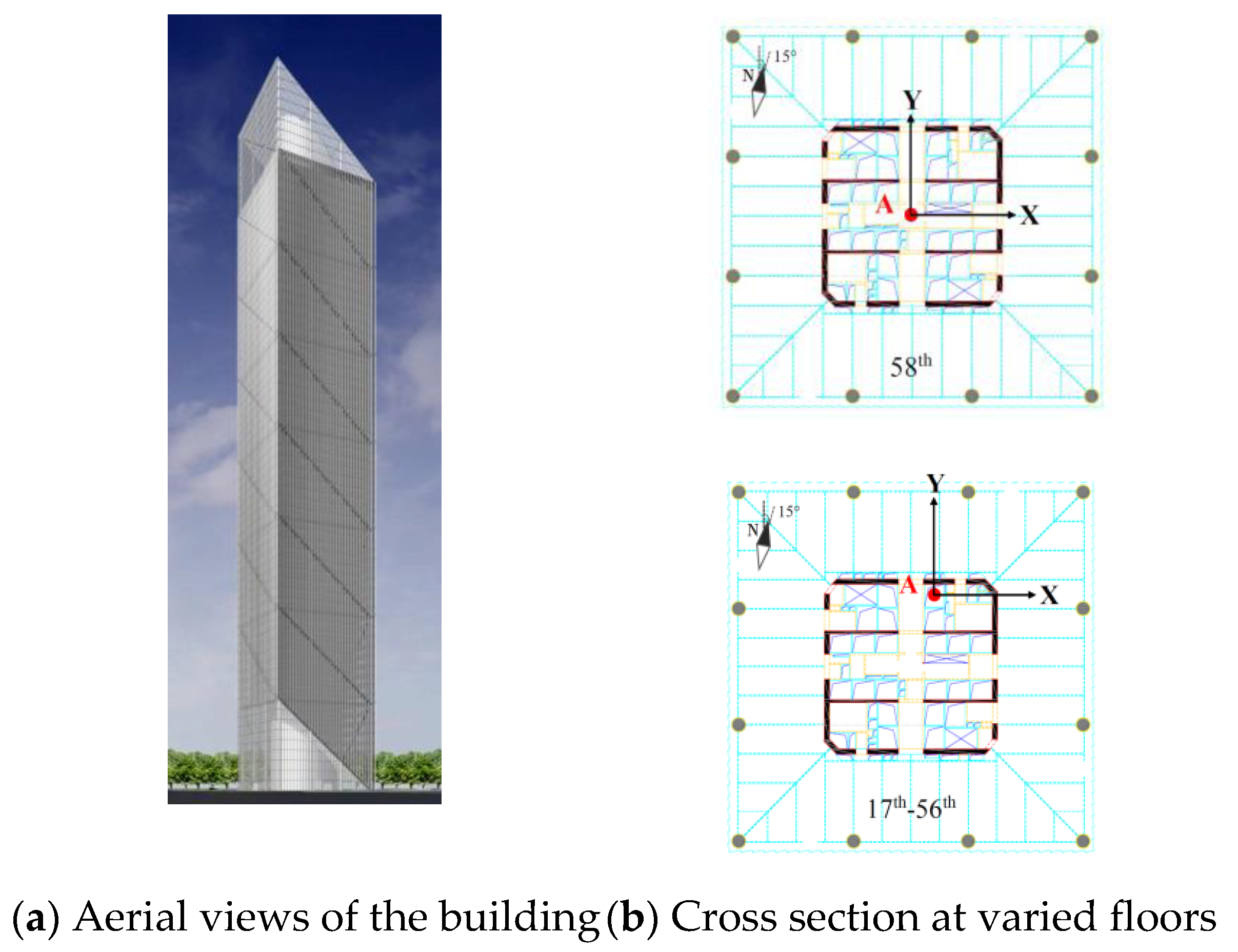
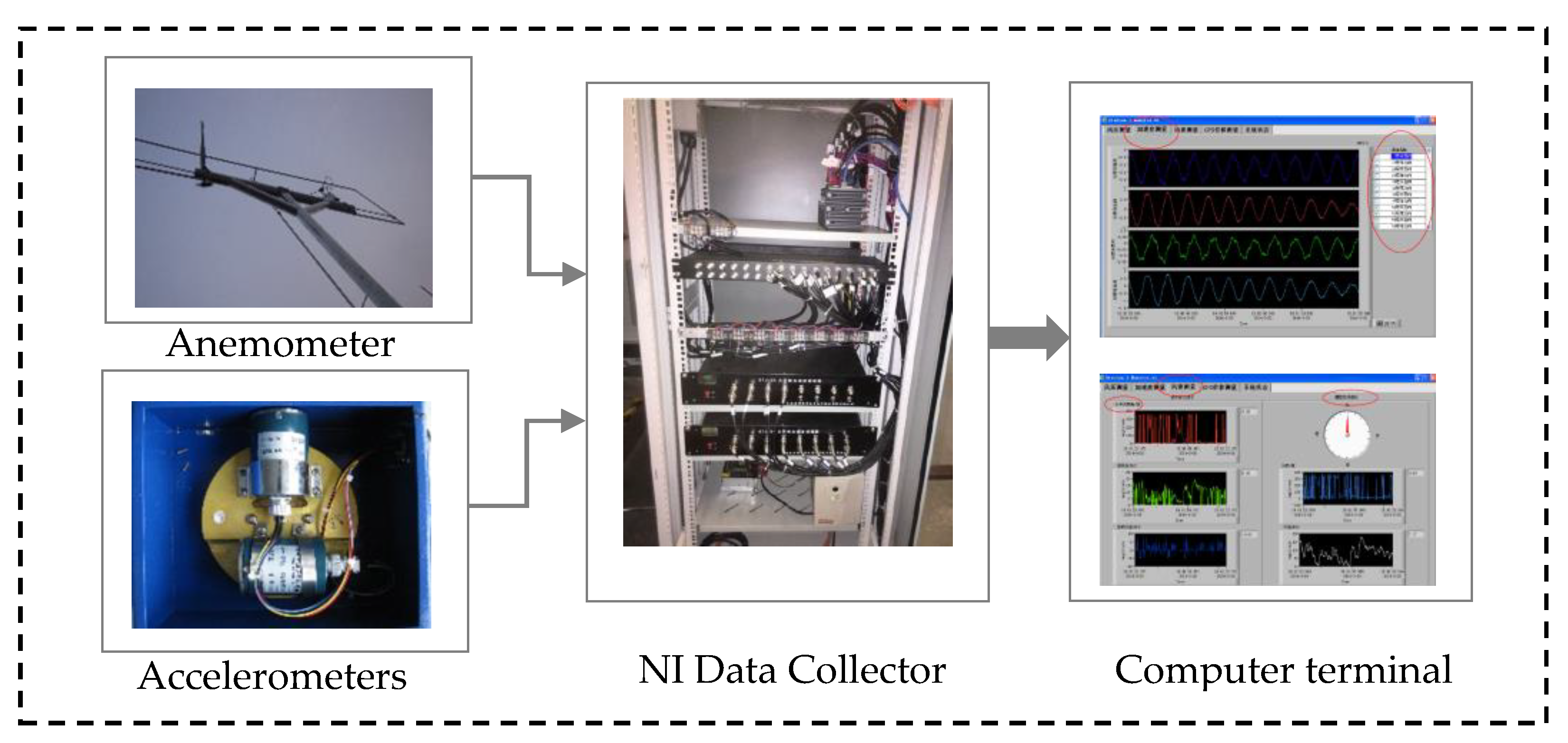
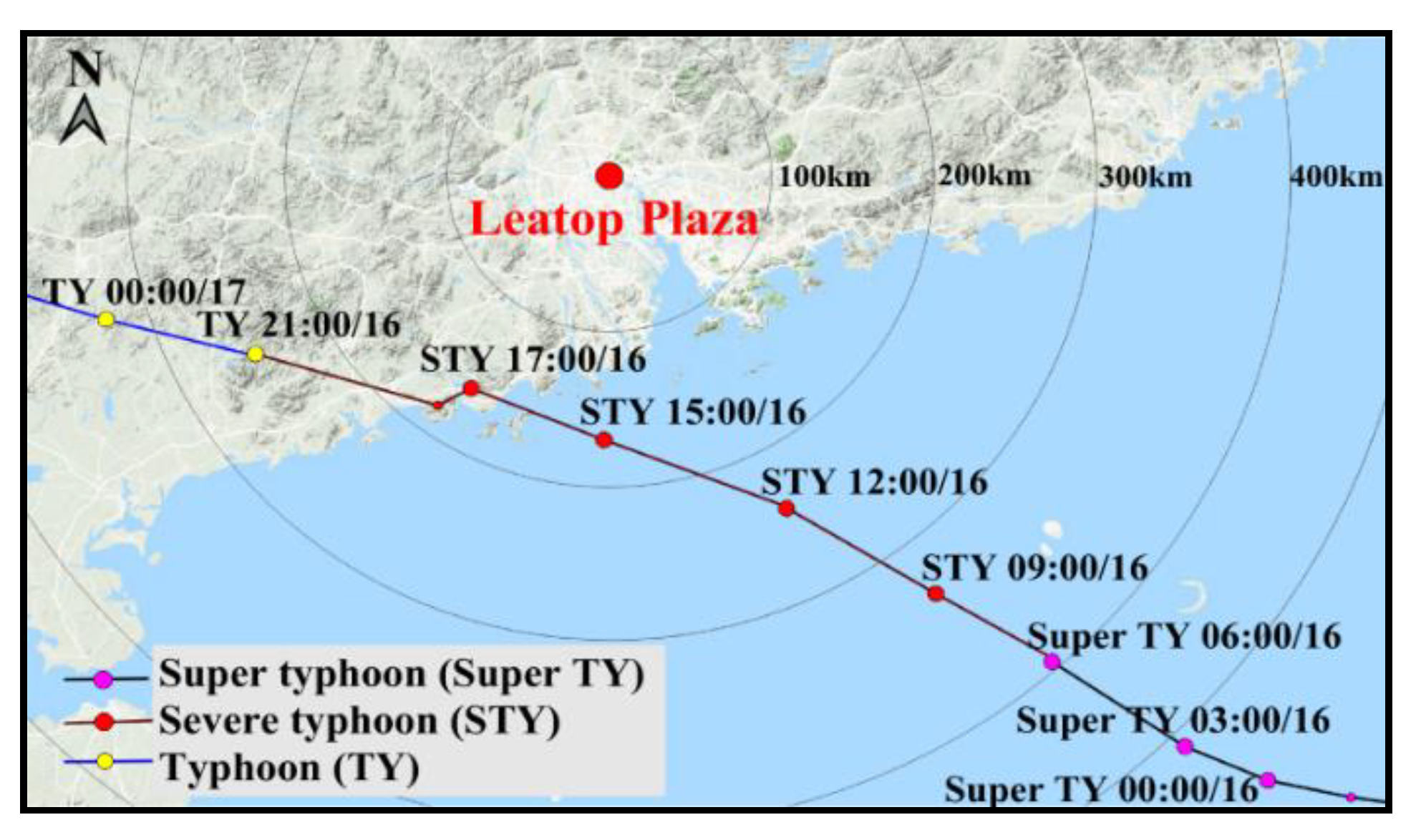
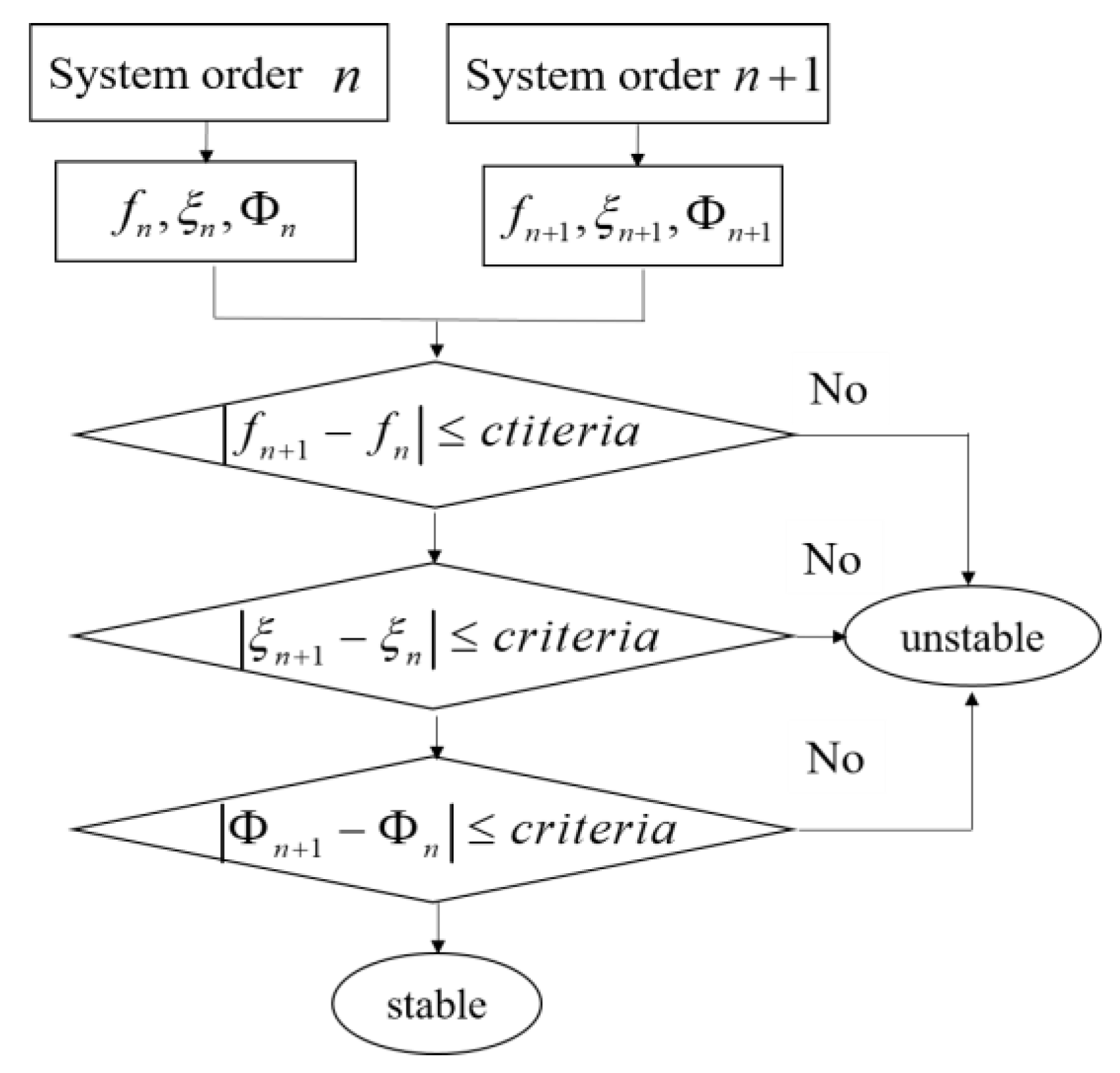
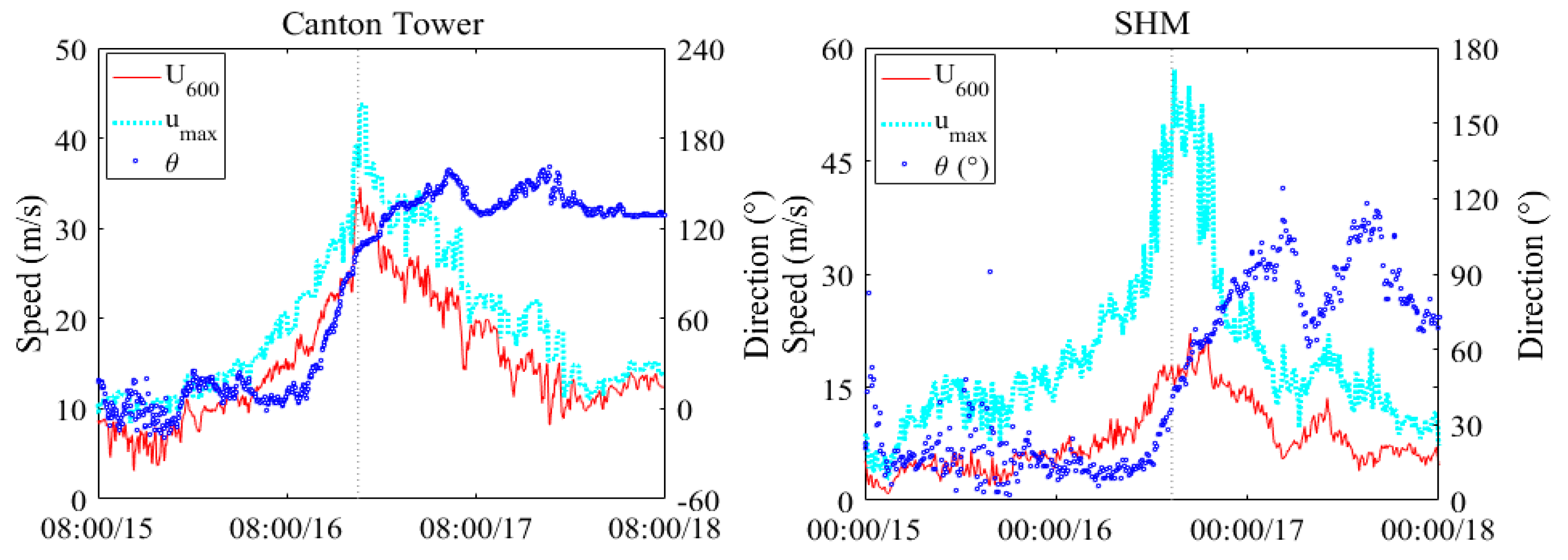
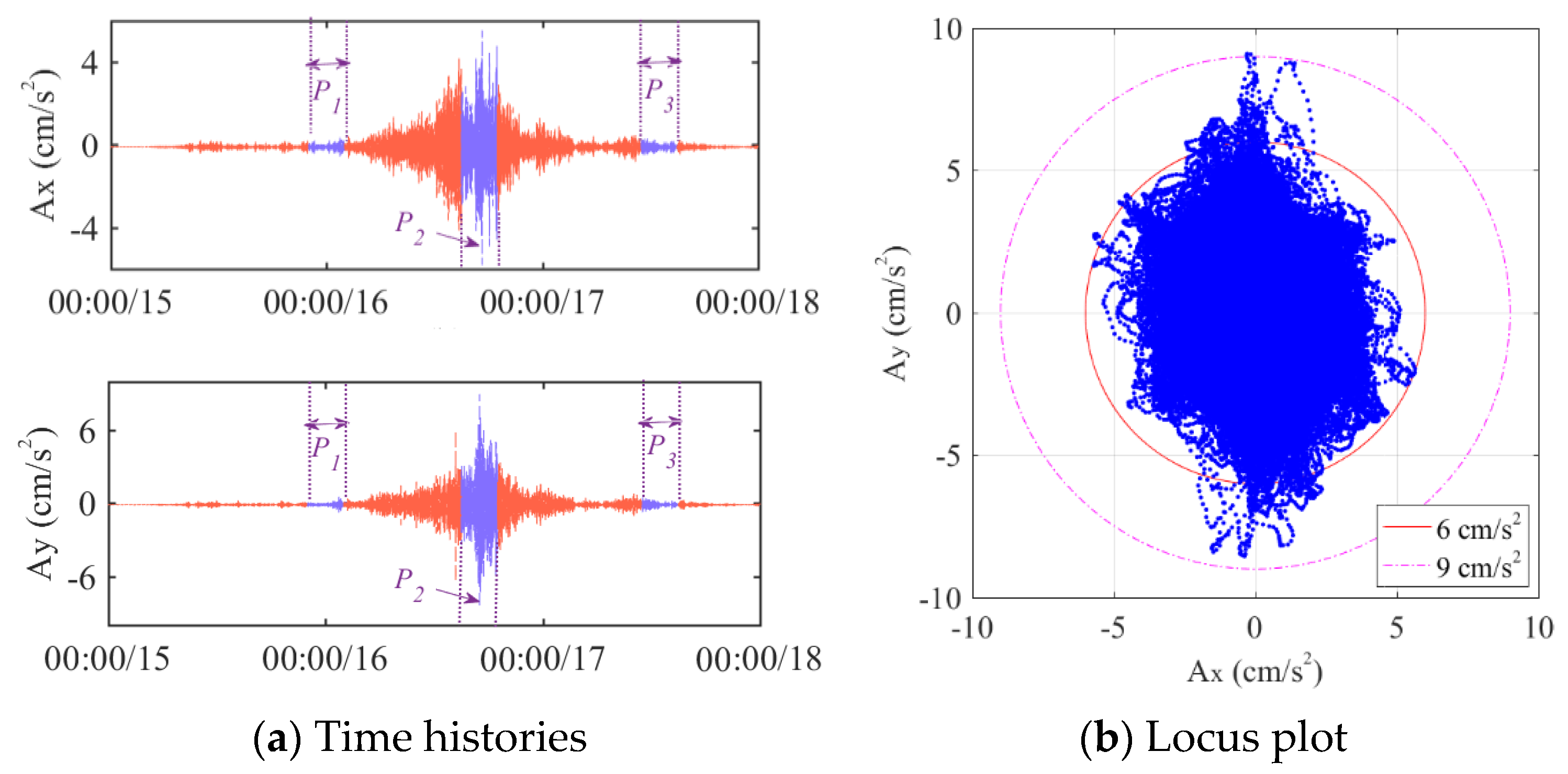
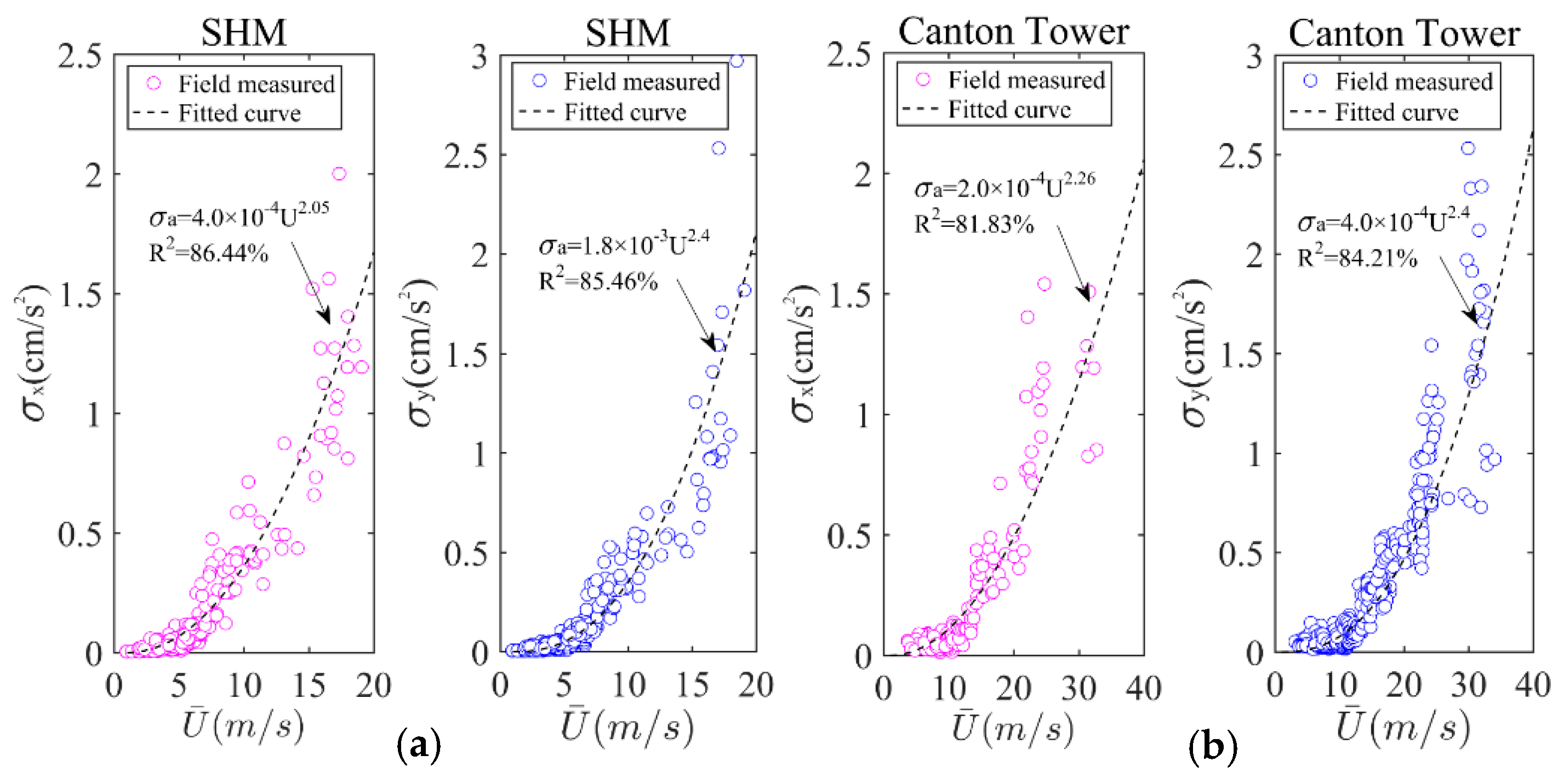
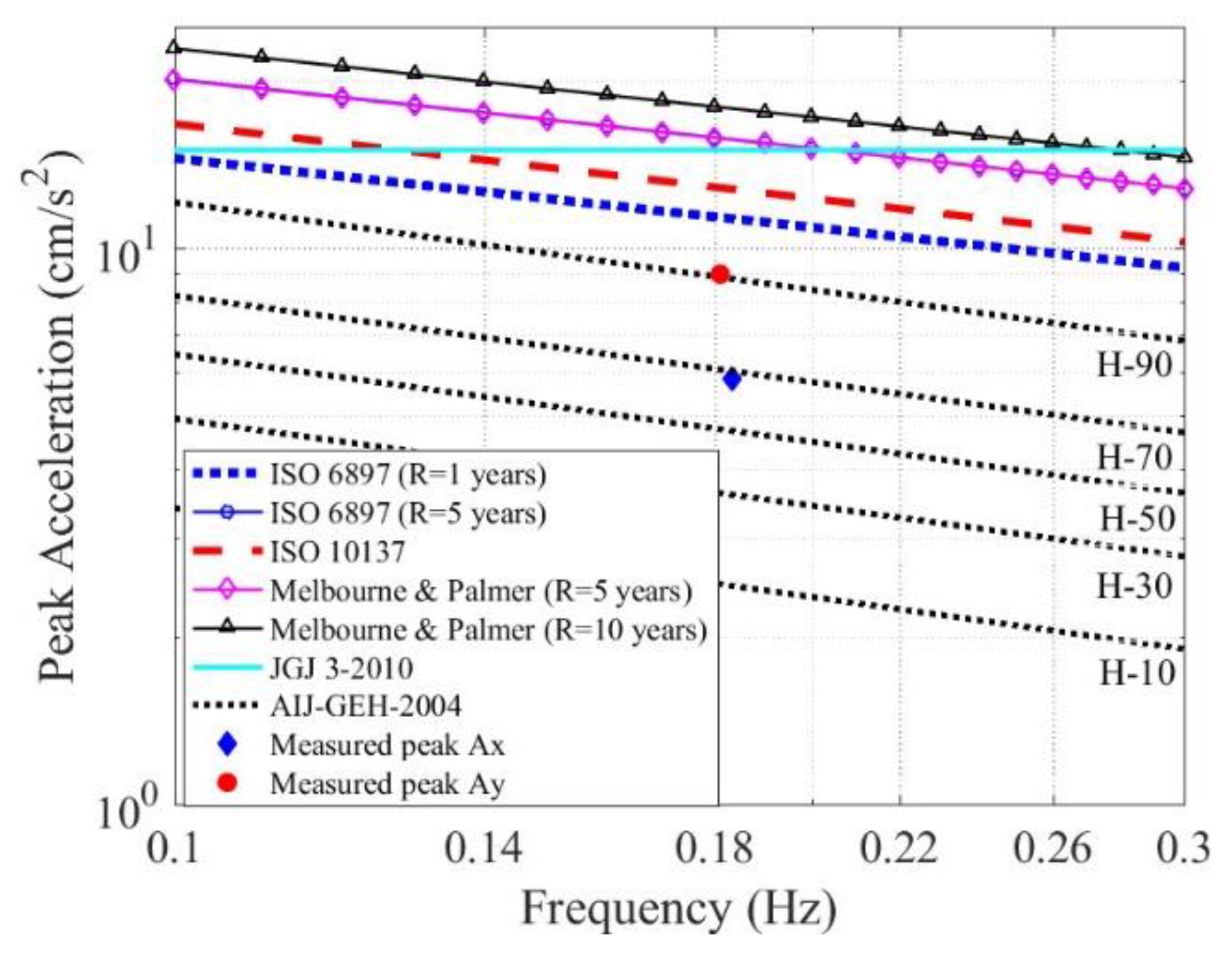
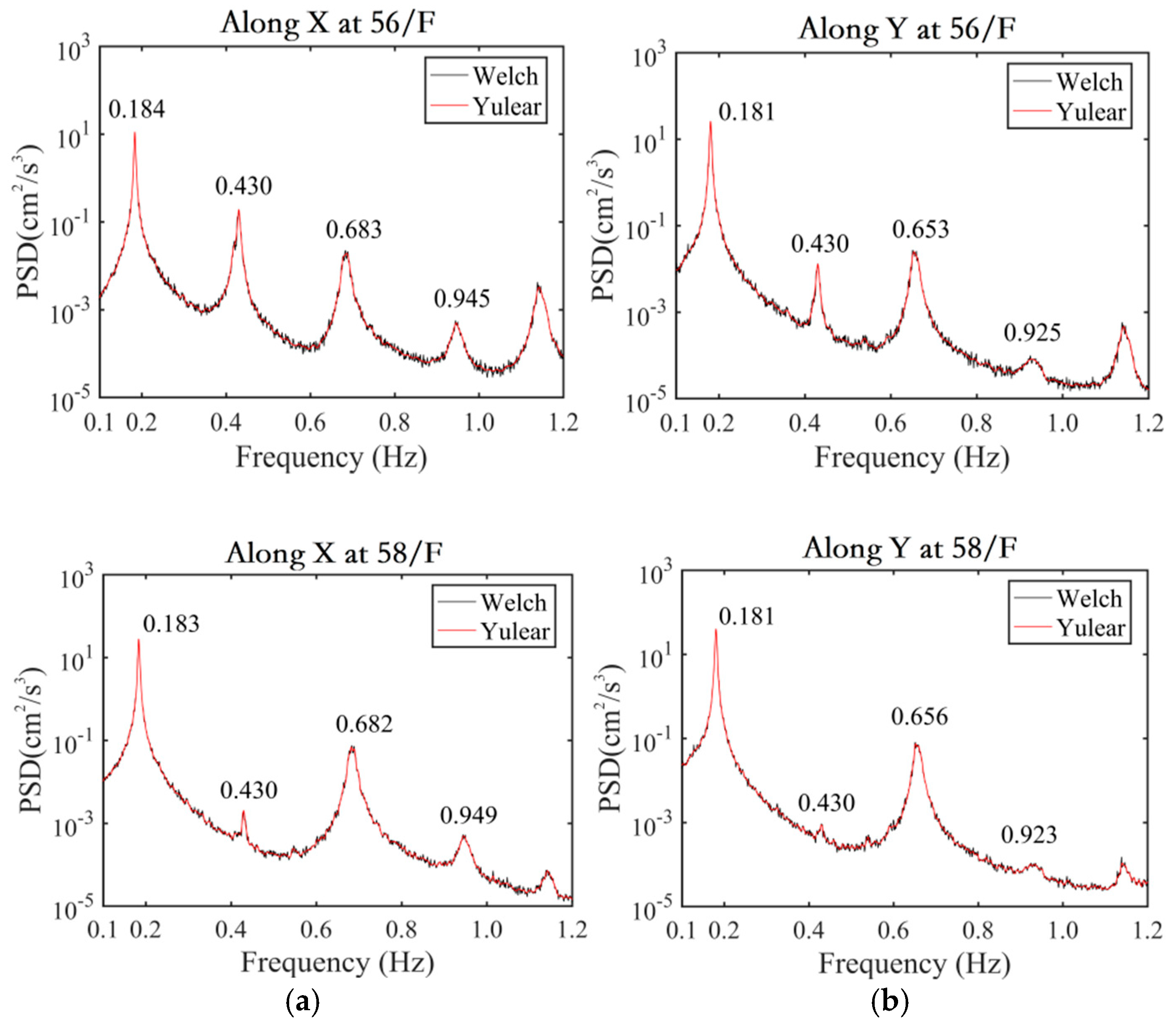
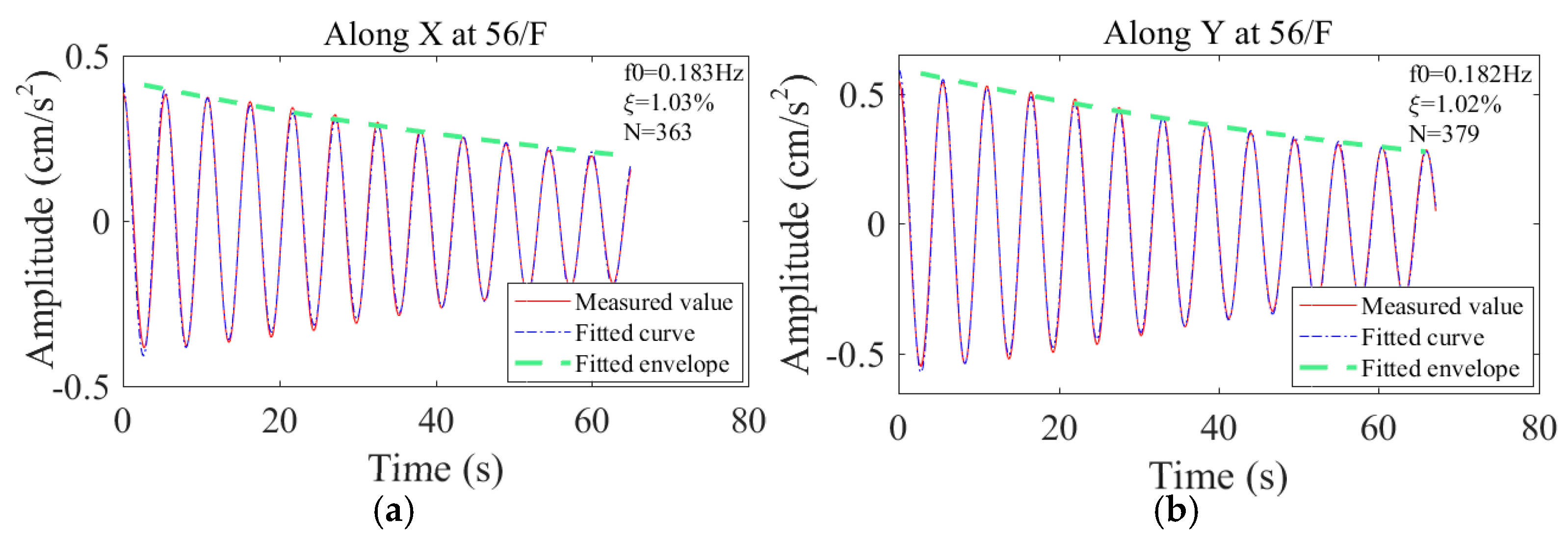
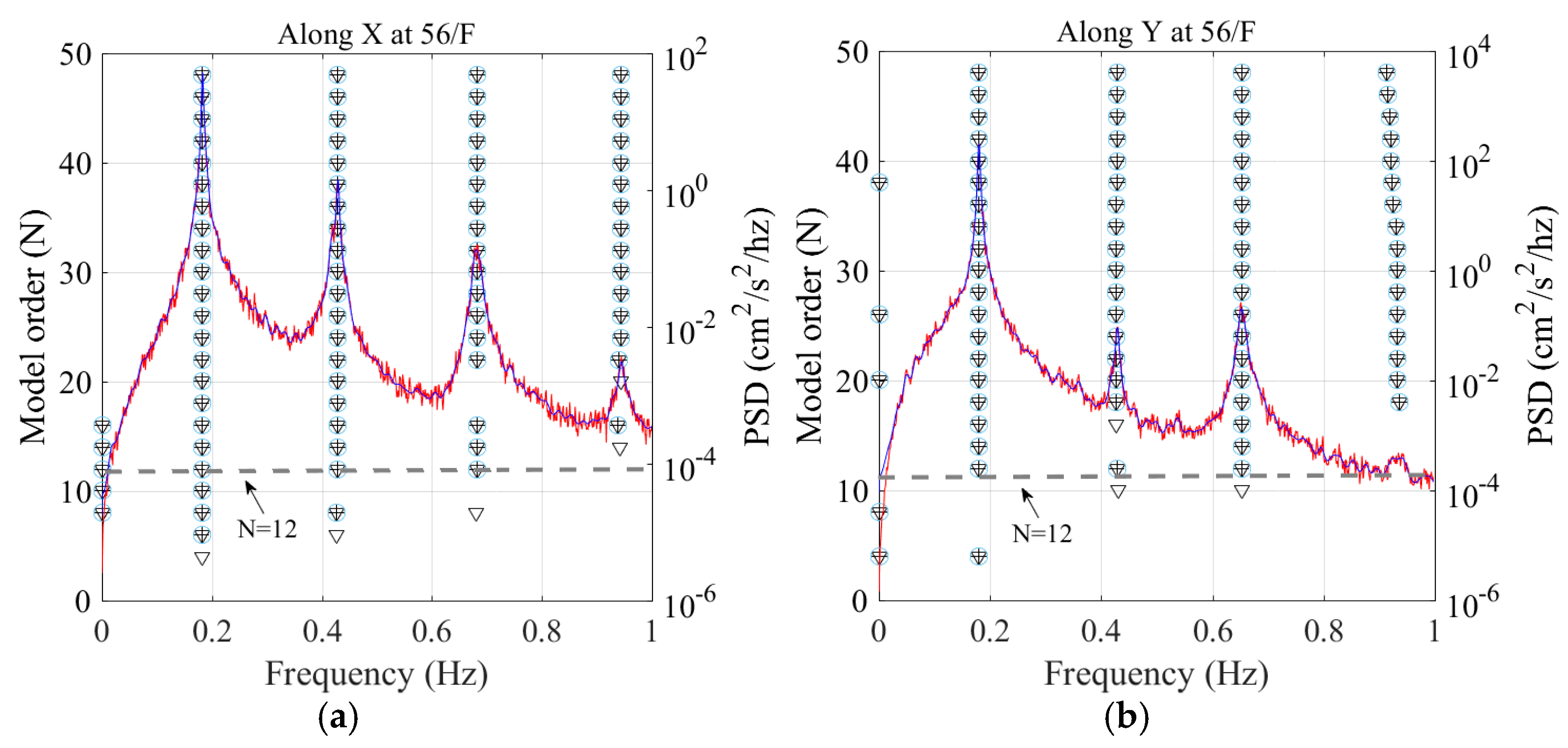
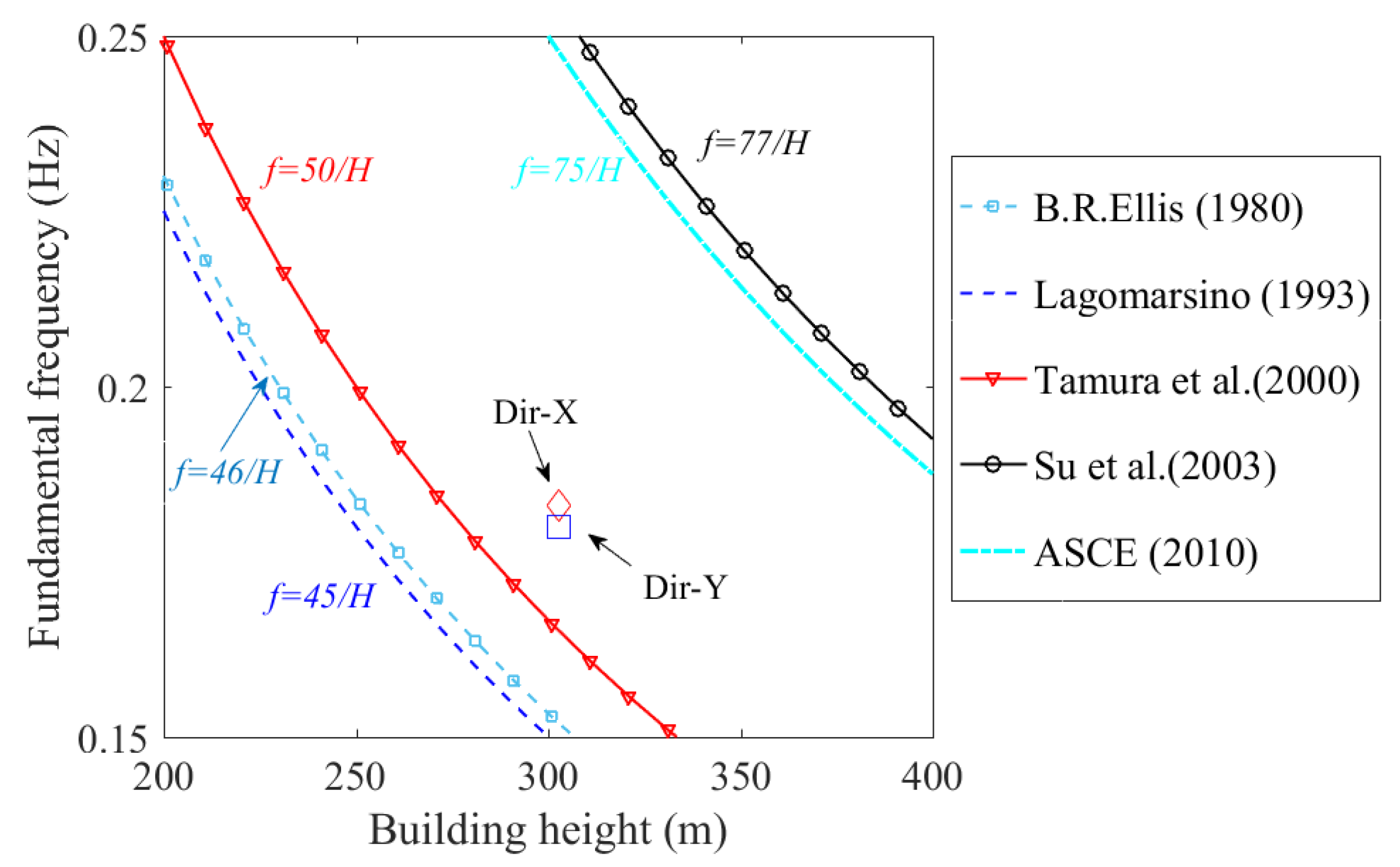
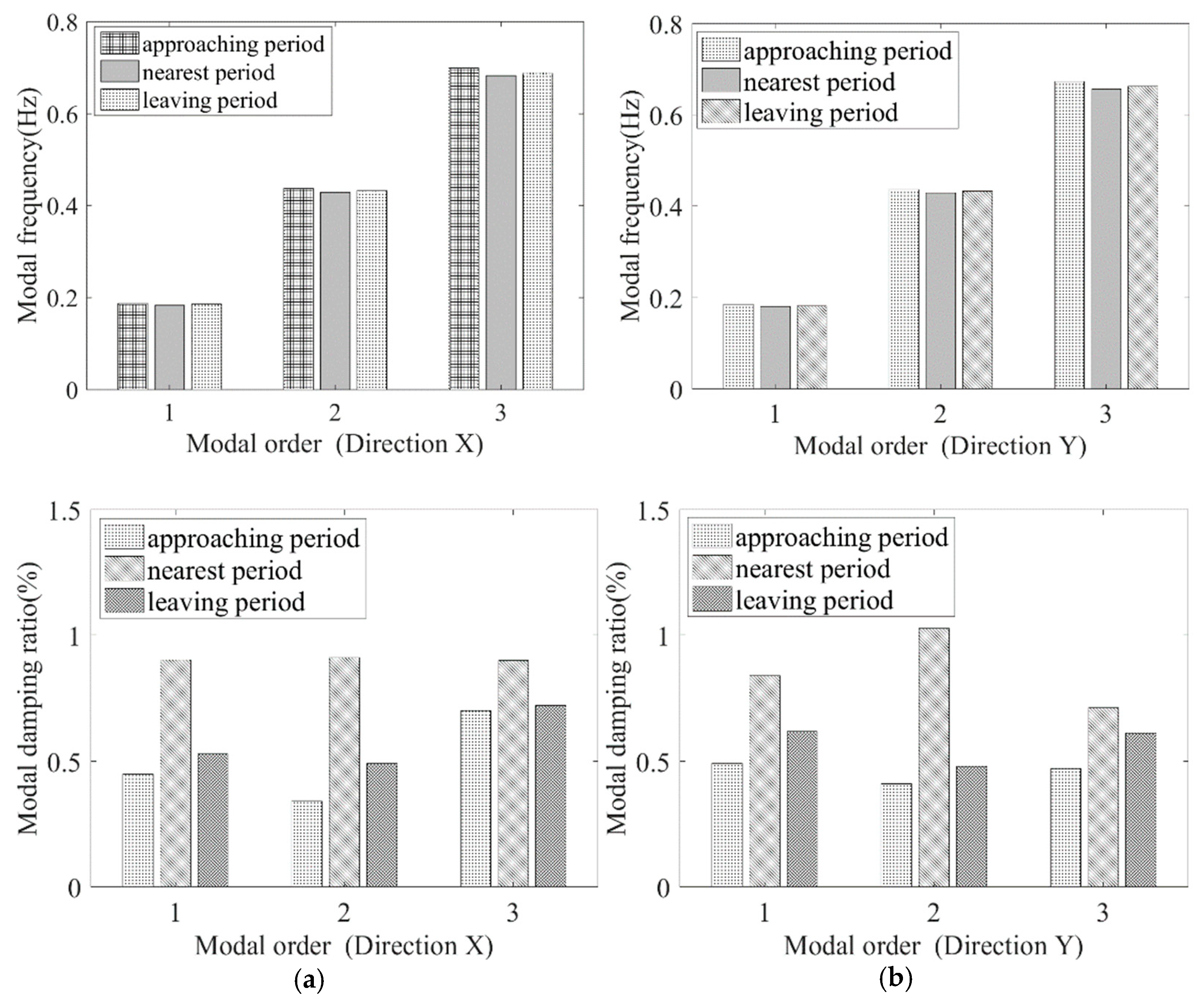

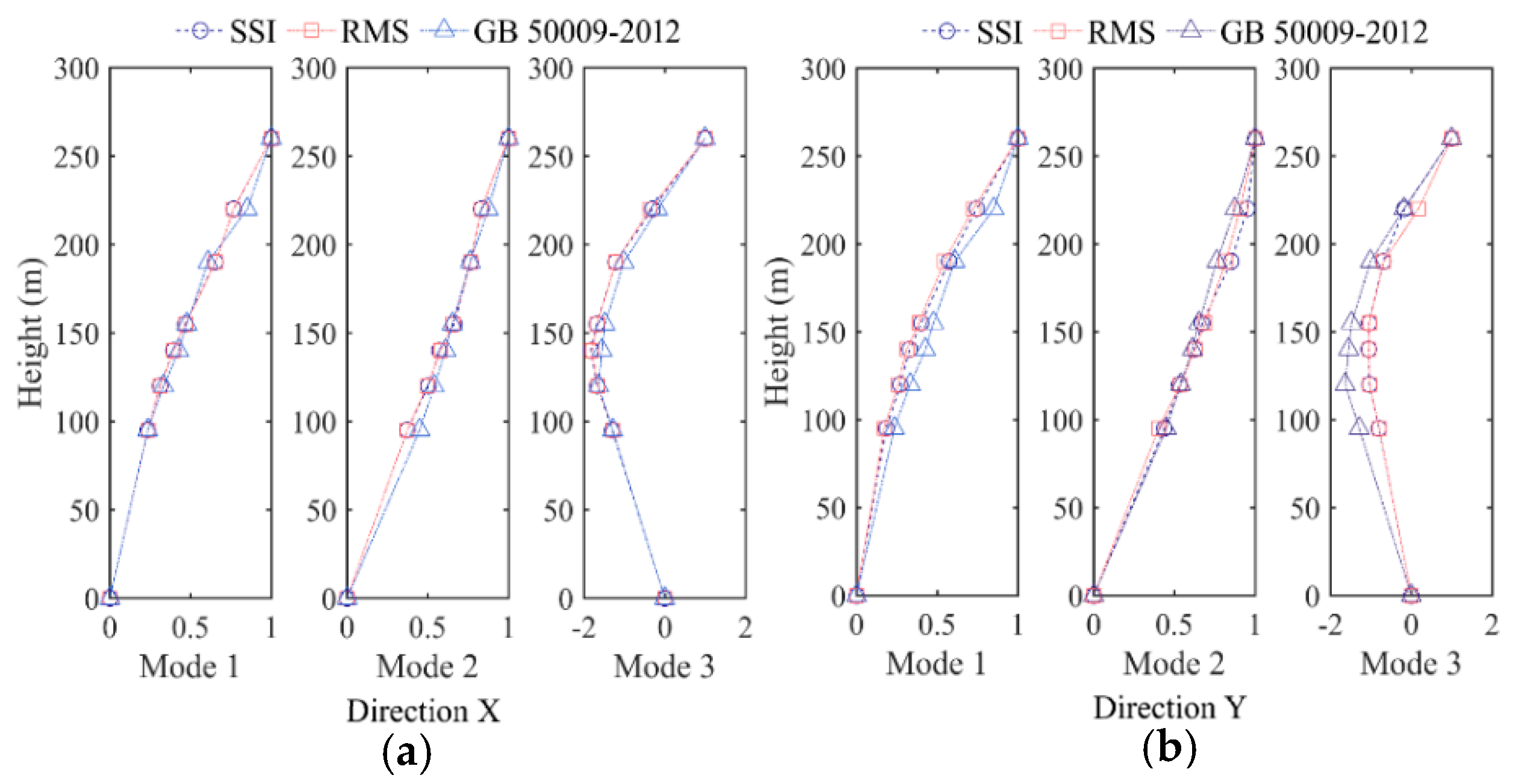
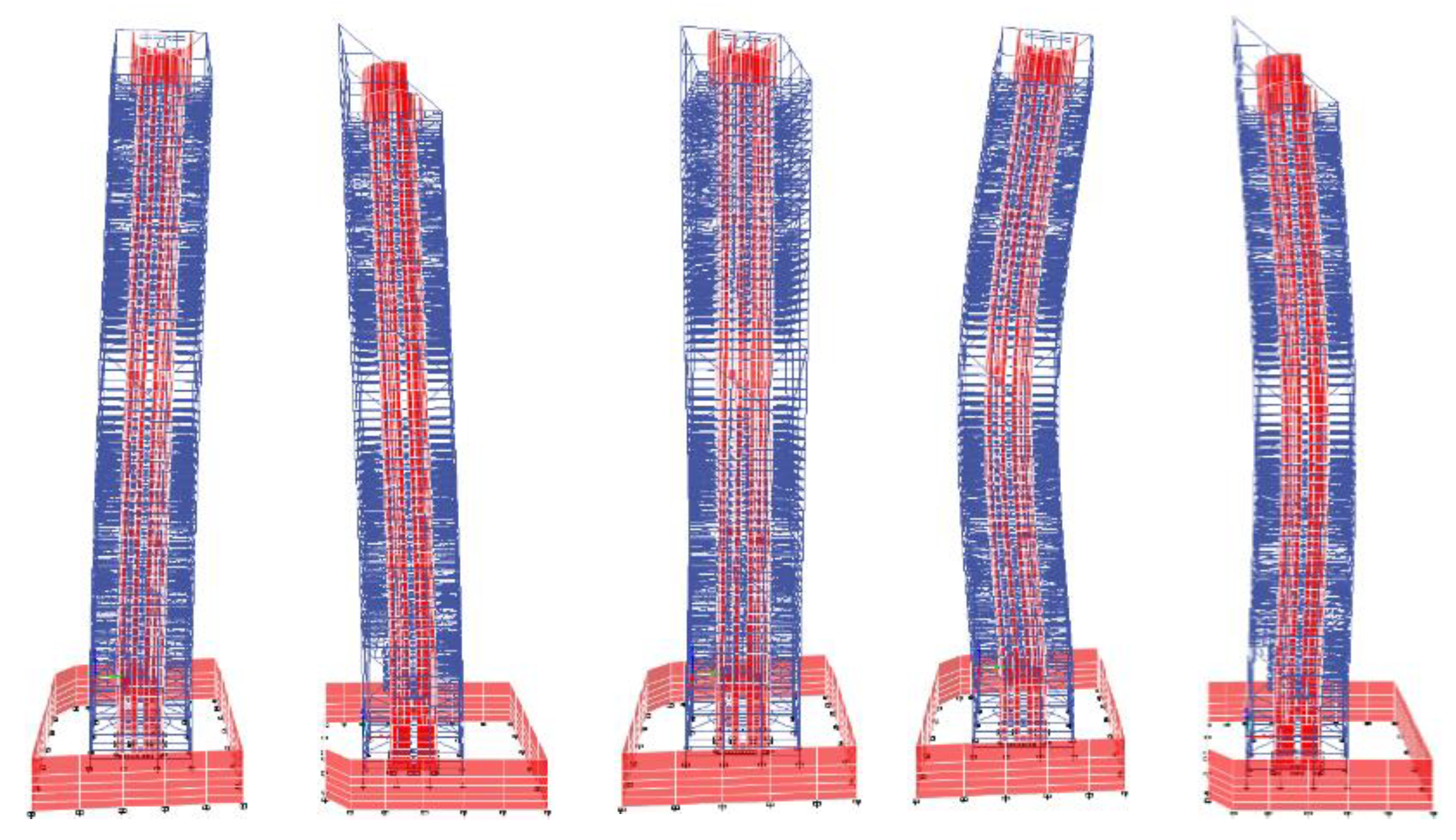
| Floor No. | Height (m) | Eccentric Distance (m) along X-Direction (East–West) | Eccentric Distance (m) along Y-Direction (North–South) |
|---|---|---|---|
| 58th | 260 | 0.2 | 0 |
| 56th | 252 | 1.7 | 9 |
| 47th | 215 | 1.7 | 9 |
| 39th | 175 | 1.7 | 9 |
| 31st | 145 | 1.7 | 9 |
| 28th | 135 | 1.7 | 9 |
| 23rd | 115 | 1.7 | 9 |
| 17th | 80 | 1.7 | 9 |
| Meteorological Station | Geographic Coordinates | Anemometer Height (m) |
|---|---|---|
| Canton Tower | 23°6′44″ N,113°19′52′ E | 532 |
| Leatop Plaza | 23°7′54′ N,113°19′56′ E | 303 |
| Dir. | Approaching Period | Nearest Period | Leaving Period | |||
|---|---|---|---|---|---|---|
| Measured | Calculated | Measured | Calculated | Measured | Calculated | |
| X | 2.99 | 3.26 | 3.03 | 3.26 | 3.03 | 3.28 |
| Y | 3.09 | 3.26 | 2.97 | 3.25 | 3.25 | 3.25 |
| Modes | 1st Swaying Mode | 1st Torsional Mode | 2nd Swaying Mode | ||||
|---|---|---|---|---|---|---|---|
| SN | EW | SN | EW | SN | EW | ||
| f | RDT (Hz) | 0.182 | 0.183 | 0.429 | 0.429 | 0.656 | 0.683 |
| SSI (Hz) | 0.180 | 0.183 | 0.442 | 0.433 | 0.679 | 0.679 | |
| Diff (%) | 1.10 | 0.00 | 3.03 | 0.930 | 3.51 | 0.590 | |
| ξ | RDT (%) | 1.02 | 1.03 | 1.03 | 0.910 | 0.710 | 0.900 |
| SSI (%) | 0.890 | 0.910 | 1.19 | 0.900 | 0.750 | 0.890 | |
| Diff. (%) | 12.8 | 11.7 | 15.9 | 1.32 | 5.34 | 1.11 | |
| Mode | 1st Swaying | 1st Torsional | 2nd Swaying | ||||
|---|---|---|---|---|---|---|---|
| Direction | Y (S–N) | X (E–W) | Y (S–N) | X (E–W) | Y (S–N) | X (E–W) | |
| f (Hz) | Approach | 0.185 | 0.186 | 0.437 | 0.437 | 0.673 | 0.699 |
| Nearest | 0.181 | 0.183 | 0.429 | 0.429 | 0.656 | 0.683 | |
| Leaving | 0.182 | 0.186 | 0.433 | 0.433 | 0.663 | 0.689 | |
| ξ (%) | Approach | 0.490 | 0.450 | 0.410 | 0.340 | 0.470 | 0.710 |
| Nearest | 0.840 | 0.900 | 1.03 | 0.910 | 0.710 | 0.890 | |
| Leaving | 0.620 | 0.530 | 0.480 | 0.490 | 0.610 | 0.720 | |
| Mode No. | Measurement (Hz) | Simulation (Hz) | Difference (%) | Mode Type |
|---|---|---|---|---|
| 1 | 0.183 | 0.164 | 10.4 | 1st mode in X direction (sway) |
| 2 | 0.182 | 0.167 | 8.24 | 1st mode in Y direction (sway) |
| 3 | 0.429 | 0.388 | 9.56 | 1st mode in Z direction (torsion) |
| 4 | 0.683 | 0.592 | 13.3 | 2nd mode in X direction (sway) |
| 5 | 0.656 | 0.612 | 6.71 | 2nd mode in Y direction (sway) |
| 1st Swaying | 1st Torsion | 2nd Swaying | |||
|---|---|---|---|---|---|
| Direction | X | Y | X(Y) | X | Y |
| MAC (%) | 99.2 | 99.7 | 97.5 | 88.2 | 77.5 |
| NMD (%) | 9.3 | 5.2 | 16.0 | 36.5 | 53.9 |
© 2020 by the authors. Licensee MDPI, Basel, Switzerland. This article is an open access article distributed under the terms and conditions of the Creative Commons Attribution (CC BY) license (http://creativecommons.org/licenses/by/4.0/).
Share and Cite
Li, Z.; Fu, J.; He, Y.; Liu, Z.; Wu, J.; Rao, R.; Ng, C.-T. Structural Responses of a Supertall Building Subjected to a Severe Typhoon at Landfall. Appl. Sci. 2020, 10, 2965. https://doi.org/10.3390/app10082965
Li Z, Fu J, He Y, Liu Z, Wu J, Rao R, Ng C-T. Structural Responses of a Supertall Building Subjected to a Severe Typhoon at Landfall. Applied Sciences. 2020; 10(8):2965. https://doi.org/10.3390/app10082965
Chicago/Turabian StyleLi, Zhi, Jiyang Fu, Yuncheng He, Zhen Liu, Jiurong Wu, Rui Rao, and Ching-Tai Ng. 2020. "Structural Responses of a Supertall Building Subjected to a Severe Typhoon at Landfall" Applied Sciences 10, no. 8: 2965. https://doi.org/10.3390/app10082965
APA StyleLi, Z., Fu, J., He, Y., Liu, Z., Wu, J., Rao, R., & Ng, C.-T. (2020). Structural Responses of a Supertall Building Subjected to a Severe Typhoon at Landfall. Applied Sciences, 10(8), 2965. https://doi.org/10.3390/app10082965








